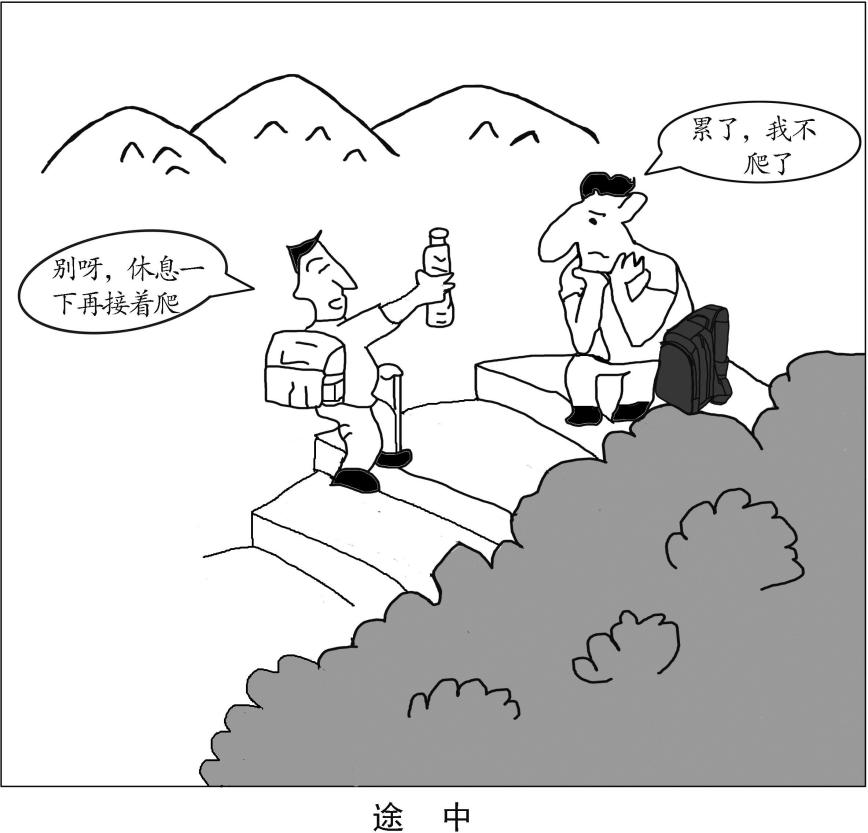|
勤奮的考研人,感謝你的點擊!無論你的關注重點是考研歷年試題,還是考確英語歷年試題,又或是考研英語答案解析,你都將在這里找到想要的干貨內容。小編為大家整理了“考研英語歷年試題——2019年考研試題及答案解析”的相關信息,快來了解一下吧!
Section I Use of English
Directions:Read the following text. Choose the best word(s) for each numbered blank and mark A, B, C or D on the ANSWER SHEET. (10 points) Today we live in a world where GPS systems, digital maps, and other navigation apps are all available on our smart phones. 1 of us just walk straight into the woods without a phone. But phones 2 on batteries, and batteries can die faster than we realize. 3 you get lost without a phone or a compass, and you 4 can’t find north, a few tricks may help you navigate 5 to civilization, one of which is to follow the land. When you find yourself well 6 a trail, but not in a completely 7 area of land, you have to answer two questions: Which 8 is downhill, in this particular area? And where is the nearest water source? Humans overwhelmingly live in valleys, and on supplies of fresh water. 9 , if you head downhill, and follow any H2O you find, you should 10 see signs of people. If you’ve explored the area before, keep an eye out for familiar sights—you may be 11 how quickly identifying a distinctive rock or tree can restore your bearings. Another 12 : Climb high and look for signs of human habitation. 13 , even in dense forest, you should be able to 14 gaps in the tree line due to roads, train tracks, and other paths people carve 15 the woods. Head toward these 16 to find a way out. At night, scan the horizon for 17 light sources, such as fires and streetlights, then walk toward the glow of light pollution. 18 , assuming you’re lost in an area humans tend to frequent, look for the 19 we leave on the landscape. Trail blazes, tire tracks, and other features can 20 you to civilization. 1. [A] Some [B] Most [C] Few [D] All 2. [A] put [B] take [C] run [D] come 3. [A] Since [B] If [C] Though [D] Until 4. [A] formally [B] relatively [C] gradually [D] literally 5. [A] back [B] next [C] around [D] away 6. [A] onto [B] off [C] across [D] along 7. [A] unattractive [B] uncrowded [C] unchanged [D] unfamiliar 8. [A] site [B] point [C] way [D] place 9. [A] So [B] Yet [C] Instead [D] Besides 10. [A] immediately [B] intentionally [C] unexpectedly [D] eventually 11. [A] surprised [B] annoyed [C] frightened [D] confused 12. [A] problem [B] option [C] view [D] result 13. [A] Above all [B] In contrast [C] On average [D] For example 14. [A] bridge [B] avoid [C] spot [D] separate 15. [A] from [B] through [C] beyond [D] under 16. [A] posts [B] links [C] shades [D] breaks 17. [A] artificial [B] mysterious [C] hidden [D] limited 18. [A] Finally [B] Consequently [C] Incidentally [D] Generally 19. [A] memories [B] marks [C] notes [D] belongings 20. [A] restrict [B] adopt [C] lead [D] expose
Section Ⅱ Reading Comprehension
Part A Directions: Read the following four texts. Answer the questions after each text by choosing A, B, C or D. Mark your answers on the ANSWER SHEET. (40 points) Text 1 Financial regulators in Britain have imposed a rather unusual rule on the bosses of big banks. Starting next year, any guaranteed bonus of top executives could be delayed 10 years if their banks are under investigation for wrongdoing. The main purpose of this “clawback” rule is to hold bankers accountable for harmful risk-taking and to restore public trust in financial institutions. Yet officials also hope for a much larger benefit: more long-term decision-making, not only by banks but by all corporations, to build a stronger economy for future generations. “Short-termism” or the desire for quick profits, has worsened in publicly traded companies, says the Bank of England’s top economist, Andrew Haldane. He quotes a giant of classical economics, Alfred Marshall, in describing this financial impatience as acting like “children who pick the plums out of their pudding to eat them at once” rather than putting them aside to be eaten last. The average time for holding a stock in both the United States and Britain, he notes, has dropped from seven years to seven months in recent decades. Transient investors, who demand high quarterly profits from companies, can hinder a firm’s efforts to invest in long-term research or to build up customer loyalty. This has been dubbed “quarterly capitalism.” In addition, new digital technologies have allowed more rapid trading of equities, quicker use of information, and thus shorter attention spans in financial markets. “There seems to be a predominance of short-term thinking at the expense of long-term investing,” said Commissioner Daniel Gallagher of the US Securities and Exchange Commission in a speech this week. In the US, the Sarbanes-Oxley Act of 2002 has pushed most public companies to defer performance bonuses for senior executives by about a year, slightly helping reduce “short-termism.” In its latest survey of CEO pay, The Wall Street Journal finds that “a substantial part” of executive pay is now tied to performance. Much more could be done to encourage “long-termism,” such as changes in the tax code and quicker disclosure of stock acquisitions. In France, shareholders who hold onto a company investment for at least two years can sometimes earn more voting rights in a company. Within companies, the right compensation design can provide incentives for executives to think beyond their own time at the company and on behalf of all stakeholders. Britain’s new rule is a reminder to bankers that society has an interest in their performance, not just for the short term but for the long term. 21. According to Paragraph 1, one motive in imposing the new rule is to [A] enhance bankers’ sense of responsibility. [B] help corporations achieve larger profits. [C] build a new system of financial regulation. [D] guarantee the bonuses of top executives. 22. Alfred Marshall is quoted to indicate [A] the conditions for generating quick profits. [B] governments’ impatience in decision-making. [C] the solid structure of publicly traded companies. [D] “short-termism” in economic activities. 23. It is argued that the influence of transient investment on public companies can be [A] indirect. [B] adverse. [C] minimal. [D] temporary. 24. The US and France examples are used to illustrate [A] the obstacles to preventing “short-termism”. [B] the significance of long-term thinking. [C] the approaches to promoting “long-termism”. [D] the prevalence of short-term thinking. 25. Which of the following would be the best title for the text? [A] Failure of Quarterly Capitalism [B] Patience as a Corporate Virtue [C] Decisiveness Required of Top Executives [D] Frustration of Risk-taking Bankers
Text 2
Grade inflation—the gradual increase in average GPAs (grade-point averages) over the past few decades—is often considered a product of a consumer era in higher education, in which students are treated like customers to be pleased. But another, related force—a policy often buried deep in course catalogs called “grade forgiveness”—is helping raise GPAs.Grade forgiveness allows students to retake a course in which they received a low grade, and the most recent grade or the highest grade is the only one that counts in calculating a student’s overall GPA. The use of this little-known practice has accelerated in recent years, as colleges continue to do their utmost to keep students in school (and paying tuition) and improve their graduation rates. When this practice first started decades ago, it was usually limited to freshmen, to give them a second chance to take a class in their first year if they struggled in their transition to college-level courses. But now most colleges, save for many selective campuses, allow all undergraduates, and even graduate students, to get their low grades forgiven. College officials tend to emphasize that the goal of grade forgiveness is less about the grade itself and more about encouraging students to retake courses critical to their degree program and graduation without incurring a big penalty. “Ultimately,” said Jack Miner, Ohio State University’s registrar, “we see students achieve more success because they retake a course and do better in subsequent courses or master the content that allows the m to graduate on time.” That said, there is a way in which grade forgiveness satisfies colleges’ own needs as well. For public institutions, state funds are sometimes tied partly to their success on metrics such as graduation rates and student retention—so better grades can, by boosting figures like those, mean more money. And anything that raises GPAs will likely make students—who, at the end of the day, are paying the bill—feel they’ve gotten a better value for their tuition dollars, which is another big concern for colleges. Indeed, grade forgiveness is just another way that universities are responding to consumers’ expectations for higher education. Since students and parents expect a college degree to lead to a job, it is in the best interest of a school to turn out graduates who are as qualified as possible—or at least appear to be. On this, students’ and colleges’ incentives seem to be aligned. 26. What is commonly regarded as the cause of grade inflation? [A] The change of course catalogs. [B] Students’ indifference to GPAs. [C] Colleges’ neglect of GPAs. [D] The influence of consumer culture. 27. What was the original purpose of grade forgiveness? [A] To help freshmen adapt to college learning. [B] To maintain colleges’ graduation rates. [C] To prepare graduates for a challenging future. [D] To increase universities’ income from tuition. 28. According to Paragraph 5, grade forgiveness enables colleges to [A] obtain more financial support. [B] boost their student enrollments. [C] improve their teaching quality. [D] meet local governments’ needs. 29. What does the phrase “to be aligned” (Para. 6) most probably mean? [A] To counterbalance each other. [B] To complement each other. [C] To be identical with each other. [D] To be contradictory to each other. 30. The author examines the practice of grade forgiveness by [A] assessing its feasibility. [B] analyzing the causes behind it. [C] comparing different views on it. [D] listing its long-run effects.
Text 3
This year marks exactly two centuries since the publication of Frankenstein; or, The Modern Prometheus, by Mary Shelley. Even before the invention of the electric light bulb, the author produced a remarkable work of speculative fiction that would foreshadow many ethical questions to be raised by technologies yet to come.Today the rapid growth of artificial intelligence (AI) raises fundamental questions: “What is intelligence, identity, or consciousness? What makes humans humans? ” What is being called artificial general intelligence, machines that would imitate the way humans think, continues to evade scientists. Yet humans remain fascinated by the idea of robots that would look, move, and respond like humans, similar to those recently depicted on popular sci-fi TV series such as “Westworld” and “Humans.” Just how people think is still far too complex to be understood, let alone reproduced, says David Eagleman, a Stanford University neuroscientist. “We are just in a situation where there are no good theories explaining what consciousness actually is and how you could ever build a machine to get there.” But that doesn’t mean crucial ethical issues involving AI aren’t at hand. The coming use of autonomous vehicles, for example, poses thorny ethical questions. Human drivers sometimes must make split-second decisions. Their reactions may be a complex combination of instant reflexes, input from past driving experiences, and what their eyes and ears tell them in that moment. AI “vision” today is not nearly as sophisticated as that of humans. And to anticipate every imaginable driving situation is a difficult programming problem. Whenever decisions are based on masses of data, “you quickly get into a lot of ethical questions,” notes Tan Kiat How, chief executive of a Singapore-based agency that is helping the government develop a voluntary code for the ethical use of AI. Along with Singapore, other governments and mega-corporations are beginning to establish their own guidelines. Britain is setting up a data ethics center. India released its AI ethics strategy this spring. On June 7 Google pledged not to “design or deploy AI” that would cause “overall harm,” or to develop AI-directed weapons or use AI for surveillance that would violate international norms. It also pledged not to deploy AI whose use would violate international laws or human rights. While the statement is vague, it represents one starting point. So does the idea that decisions made by AI systems should be explainable, transparent, and fair. To put it another way: How can we make sure that the thinking of intelligent machines reflects humanity’s highest values? Only then will they be useful servants and not Frankenstein’s out-of-control monster. 31. Mary Shelley’s novel Frankenstein is mentioned because it [A] fascinates AI scientists all over the world. [B] has remained popular for as long as 200 years. [C] involves some concerns raised by AI today. [D] has sparked serious ethical controversies. 32. In David Eagleman’s opinion, our current knowledge of consciousness [A] helps explain artificial intelligence. [B] can be misleading to robot making. [C] inspires popular sci-fi TV series. [D] is too limited for us to reproduce it. 33. The solution to the ethical issues brought by autonomous vehicles [A] can hardly ever be found. [B] is still beyond our capacity. [C] causes little public concern. [D] has aroused much curiosity. 34. The author’s attitude toward Google’s pledges is one of [A] affirmation. [B] skepticism. [C] contempt. [D] respect. 35. Which of the following would be the best title for the text? [A] AI’s Future: In the Hands of Tech Giants [B] Frankenstein, the Novel Predicting the Age of AI [C] The Conscience of AI: Complex But Inevitable [D] AI Shall Be Killers Once Out of Control ...... Part B 52. Directions: Write an essay of 160-200 words based on the picture below. In your essay, you should 1) describe the picture briefly, 2) interpret the implied meaning, and 3) give your comments. You should write neatly on the ANSWER SHEET. (20 points) 
考研英語歷年試題——2019年考研試題及答案解析
Section I Use of English
1.【答案】[C]【解析】上一句指出,全球定位系統、數字地圖和其他導航應用程序都可以在智能手機上使用。按照語義的連貫性,空格所在句應該是說“很少有人”會在不攜帶手機的情況下就直接走進森林,[C]項Few(很少,幾乎沒有)與without構成雙重否定,符合上下文語義,故為答案。[A]項Some(一些)、[B]項Most(大多數)和[D]項All(所有)代入文中均不能使上下文形成合理的語義銜接。 2.【答案】[C] 【解析】[C]項run可與on構成合理搭配,run on sh.意為“靠……運行”,代入句中表示“手機依靠電池運行”,語義通順,故答案為[C]項。put on表示“穿上;播放;使運轉”,take on表示“承擔;呈現”,come on表示“開始運轉,開始工作”。[A]項put、[B]項take和[D]項come構成的短語均不能與batteries形成合理的語義銜接。 3.【答案】[B] 【解析】結合上下文語義來看,此處是一種假設的情況,[B]項If(如果)表示假設,代入句中邏輯通順,故為答案。[A]項Since(因為,既然;自從)、[C]項Though(盡管,雖然)和[D]項Until(直到……才)代入文中均不能使上下文形成合理的邏輯銜接。 4.【答案】[D] 【解析】空格所在句意思比較完整,空格處需要填入一個副詞,[D]項literally(真正地,確實地)可表強調,代入句中表示“你確實找不著北了”,與and前“迷路”的表述相一致,故答案為[D]項。[A]項formally(正式地;禮貌地)、[B]項relatively(相對地)和[C]項gradually(逐漸地)代入文中明顯語義不通。 5.【答案】[A] 【解析】前面講到“迷路了(lost)”,此處應該是說一些竅門指引你“找到回去的路”,[A]項back(返回,回到原處)正好與lost(迷路)相呼應,符合此處的語義和邏輯,故為答案。[B]項next(下次;緊接著,隨后)、[C]項around(在四周,圍繞)和[D]項away(遠離)代入文中語義和邏輯均不通順。 6.【答案】[B] 【解析】通過上段內容可知,本段是介紹迷路時找到路的具體方法,再結合冒號后面關于地形的兩個問題以及空格后的trail(路線)不難推測,空格處所表達的應該是類似“迷路,偏離路線”之意,[B]項off(偏離,離開)符合此處語義,故為答案。[A]項onto(在……之上)和[C]項across(穿過,跨越)代入句中均不能使上下文形成合理的語義銜接;[D]項along(沿著)代入文中前后語義矛盾。 7.【答案】[D] 【解析】but前面說的是“迷路了”,but后面的內容既要能夠與“迷路了”這一語義相銜接,又要與其構成語義上的轉折關系,四個選項中只有[D]項unfamiliar(不熟悉的)符合此處的語義和邏輯,故為答案。此處表示“雖然迷路了,但并不是在一個完全不熟悉的區域”。[A]項unattractive(不吸引人的)、[B]項uncrowded(不擁擠的)和[C]項unchanged(未改變的)代入文中均不能使but前后的內容構成轉折的語義關系。 8.【答案】[C] 【解析】空格后的downhill表示“向下;下坡”,[C]項way(方向;道路)代入文中表示“哪個方向或哪一條路是下坡的?”,語義通順,且與前面所講的“迷路了”的語境相符,故答案為[C]項。[A]項site(地點,位置;場所)、[B]項point(地點;要點)和[D]項place(地方,地點)均無法與后面的方位副詞downhill(向下,下坡)形成合理的語義關系。 9.【答案】[A] 【解析】從前后句意來看,“生活在山谷中的人們依靠淡水為生”與“沿著發現的任何‘水分子’一直向下走應該會看到人煙”之間存在因果關系,[A]項So(因此)符合此處邏輯,故為答案。[B]項Yet(然而)、[C]項Instead(反而,而不是)和[D]項Besides(此外)代入文中均不能使空格前后形成合理的邏輯銜接。 10.【答案】[D] 【解析】[D]項eventually(最后,終于)代入句中表示“沿著你發現的任何‘水分子’一直走,你最終應該會看到人煙”,語義通順,且符合上下文語境,故答案為[D]項。[A]項immediately(立即)和[C]項unexpectedly(意外地,出乎意料地)雖然也能使空格所在分句語義通順,但無法與上文形成合理的語義銜接;[B]項intentionally故意地,有意地)代入文中語義不通。 11.【答案】[A] 【解析】破折號后的內容是對其前建議“密切關注熟悉景物”的解釋說明,表明這么做的意義:認出某熟悉景物會讓人迅速找回方向感。how quickly體現出對耗時之短的驚嘆,空格處所填詞應與此驚嘆語氣一致,四個選項中只有[A]項surprised(驚訝)符合此處語義,故為答案。[B]項annoyed(生氣)、[C]項frightened(害怕)和[D]項confused(困惑)代入文中均無法形成合理的語義銜接。 12.【答案】[B] 【解析】第一段結尾引出主題:一些竅門能夠指引你回到文明社會。隨后具體介紹第一種竅門(one of which is...),空格前的another(另一個)與第一段中的one相呼應,再結合冒號后面的內容可知,本段應該是介紹另一種方法,[B]項option(選擇,選項)代入句中表示“另一個選擇”,符合語義,故為答案。[A]項problem(問題)、[C]項view(觀點,看法)和[D]項result(結果)明顯不符合上下文語境。 13.【答案】[D] 【解析】空格前面的句子是本段的主題句“另一個選擇:登高并尋找人類居住的跡象”,空格所在句則具體講述在茂密的森林里可以通過尋找樹木間的缺口來找到出去的路,這應該是對該方法的舉例說明,故答案為[D]項For example(例如)。[A]項Above all(首先;尤其是)、[B]項In contrast(相反;相比之下)和[C]項On average(平均來說)代入文中均不能使上下文形成合理的邏輯和語義銜接。 14.【答案】[C] 【解析】此處是對前面提到的“登高并尋找(look for)人類居住的跡象”這一方法的舉例說明,gaps in the tree line(樹木間的缺口)對應signs(痕跡),由此可推測,空格所填詞應該與look for意思接近,[C]項spot(發現)符合這一語義,故為答案。[A]項bridge做動詞時常與gap搭配,表示“彌合差距,消除隔閡(或分歧等)”,與此處語境不符;[B]項avoid(避免)和[D]項separate(使分離,分開)代入文中均語義不通。 15.【答案】[B] 【解析】people carve the woods是省略了引導詞that的定語從句,修飾“roads,train tracks,and other paths”。根據常識可知,森林里的小路應該是穿過森林開鑿出來的,[B]項through(通過,穿過)符合語義,故為答案。[A]項from(來自;從)、[C]項beyond(超出;在……另一邊)和[D]項under(在……下面)代入文中均語義不通。 16.【答案】[D] 【解析】空格前的指示代詞these提示,空格所填詞應指代上文中的某一名詞;上一句提到,即便是在茂密的森林里,你應該也能發現樹木間的缺口(gaps in the tree line);按照上下文的語義銜接,these 應該是指代gaps in the tree line,[D]項breaks(缺口,裂口,裂縫)與gaps(缺口,開口,裂縫)意思接近,符合此處的指代和語義,故為答案。[A]項posts(職位;柱,桿,樁)、[B]項links(連接)和[C]項shades(陰影;遮光物)代入文中均無法在上文找到對應的指代內容。 17.【答案】[A] 【解析】空格后的such as fires and streetlights是對 light sources的列舉說明,眾所周知,火光(fires)和路燈(streetlights)屬于人造光源,[A]項artificial(人造的)代入句中表示“人造光源”,符合fires(火)和streetlights(路燈)的特點;此外,scan...for light sources 與段首主題句中look for signs of human habitation形成呼應,artificial正好與human屬于同一語義場,故答案為[A]項。[B]項mysterious(神秘的)、[C]項hidden(隱藏的)和[D]項limited(有限的)代入文中均不能使上下文形成合理的語義銜接。 18.【答案】[A] 【解析】空格位于段首,并由逗號與后面的內容隔開,故應考慮與上文的邏輯銜接。第一段提到本文會介紹一些竅門指引迷路的人返回文明社會,本段為最后一段,此處應該是介紹最后一種方法,[A]項Finally(最后)符合此處邏輯,故為答案。[B]項Consequently(因此,所以)、[C]項Incidentally(順便提一下;偶然地)和[D]項Generally(總體來說;一般,通常)代入文中均不能使上下文形成合理的邏輯銜接。 19.【答案】[B] 【解析】分析空格所在句結構可知,we leave on the landscape為省略了引導詞that的定語從句,修飾空格所填詞,且所填詞為leave的邏輯賓語;再結合句意可知,所填詞表示“人們留下的可以幫助迷路的人找到出路的某種事物或信息”,[B]項marks(痕跡;標志,記號)符合語境,故為答案。下一句中具體列舉的trail blazes(樹皮上的記號)、tire tracks(輪胎痕跡)等標記又進一步確定了答案。[A]項memories(記憶)、[C]項notes(筆記,記錄)和[D]項belongings(所有物)也可以做leave的賓語,但均不符合語境,無法涵蓋后面trail blazes、tire tracks的含義。 20.【答案】[C] 【解析】結合上一句可知,此處講的是迷路時可以通過尋找樹皮上的記號、輪胎痕跡等人們留下的標記來找到出路,[C]項lead(引導,引領)常與to搭配,代入句中表示“引導你回到文明社會”,符合上下文語境,故答案為[C]項。[A]項restrict(限制,約束)、[B]項adapt(使適應)和[D]項expose(使顯露,使暴露)都可與to搭配,但代入文中均語義不通。
Section II Reading Comprehension
Part AText 121.【答案】[A]【解析】根據題干信息Paragraph 1和one motive...rule定位到第一段第三句。該句指出,這項“追回”規定的主要目的是讓銀行家為有害的冒險行為承擔責任(hold bankers accountable for harmful risk-taking),并恢復公眾對金融機構的信任。由此可知,[A]項是實行該項新規定的一個主要目的,故為答案,該項中的responsibility“同義替換”原文中的accountable。 22.【答案】[D] 【解析】根據題干信息Alfred Marshall和quoted定位到第二段最后一句。該句提到,英格蘭銀行的首席經濟學家安德魯•霍爾丹引用了古典經濟學巨匠阿爾弗雷德•馬歇爾的話,把這種金融上的急躁(this financial impatience)描述為像“孩子們從布丁里挑出李子馬上吃掉”一樣的行為,而不是把它們放在一邊,留到最后吃;this financial impatience指代該段首句提到的short-termism,可見引用阿爾弗雷德•馬歇爾的話就是為了說明經濟活動中的“短期主義”,故答案為[D]項。 23.【答案】[B] 【解析】根據題干信息transient investment定位到第三段第二句。該句指出,要求從公司獲得高額季度利潤的短期投資者(transient investors)會阻礙(hinder)公司在投資長期研究或建立客戶忠誠度方面的努力。由hinder一詞可推斷,本文認為短期投資可能會給公司帶來“不利”影響,故答案為[B]項。 24.【答案】[C] 【解析】根據題干信息US和France分別定位到第五段和第六段。第五段為美國的例子,第六段為法國的例子。第五段中提到美國迫使上市公司推遲發放高管績效獎金的措施,使“短期主義”有所減少(helping reduce “short-termism”);第六段提到法國為鼓勵“長期主義”采取的措施(to encourage “long-termism”):持有公司投資兩年以上的股東可以擁有更多的表決權。歸納兩段內容可知,美國和法國的例子都是為了說明如何限制“短期主義”和推行“長期主義”,故答案為[C]項。 25.【答案】[B] 【解析】第一段由一項延遲發放銀行高管固定獎金的金融措施引出全文中心話題:促進金融投資的長期規劃(long-term decision-making);第二至四段指出目前“短期主義(short-termism)”投資占主流的現象及弊端;第五、六段介紹美法兩國為推行“長期主義(long-termism)”所采取的措施;最后一段呼應第一段,點明英國金融新規定提醒銀行家們注重“長期主義”。綜合可知,本文批判了西方國家金融投資中的“短期主義”,主張要注重并推行“長期主義”。四個選項中只有[B]項與本文主題相符,最適合作為本文標題。該項中,patience(耐心)對應long-termism,而virtue(美德)是對“長期主義”的肯定。此外,第二段中提到this financial impatience(這種金融上的急躁),也對答案起到提示作用。 Text 226.【答案】[D]【解析】根據題干信息grade inflation定位到第一段第一句。該句提到grade inflation(分數膨脹),破折號中間是對其含義的解釋,隨后指出了它背后的原因:它常常被認為是高等教育在消費時代的產物(often considered a product of a consumer era),學生被當作需要取悅的顧客對待。[D]項正是對該原因的同義轉述,故為答案。題干中的is commonly regarded對應原文中的is often considered。 27.【答案】[A] 【解析】根據題干信息original purpose定位到第三段第二句。該句指出,幾十年前,這種做法(成績寬恕)剛開始施行時,通常只限于大一新生,目的是在他們向大學水平課程艱難過渡的過程中給予他們在第一學年重修一門課程的機會。[A]項正是對這一目的的同義轉述,故為答案。 28.【答案】[A] 【解析】根據題干信息Paragraph 5和enables colleges定位到第五段第一句。該句指出,“成績寬恕”也可以通過某種方式滿足大學自身的需求(satisfies colleges’ own needs),題干中的enables colleges對應該句中的satisfies colleges,但具體如何滿足大學需求并未在該句中說明,而是在第二句中有所體現:對于公立院校來說,國家的資金投入有時部分取決于它們在畢業率、學生在讀率等指標上的成功——因此,成績越好,就越能提升那些數據,從而得到更多資金(better grades...mean more money)。可見,“成績寬恕”政策可以提高學生的成績,繼而使大學獲取國家更多的資金投入。[A]項表述與此相符,故為答案,其中more financial support對應原文中的more money。 29.【答案】[C] 【解析】根據題干信息“to be aligned”(Para. 6)定位到第六段最后一句。要理解to be aligned的含義,需要明確this指代的內容。上文提到,學生和家長希望通過獲得大學學位找到一份工作,那么培養出盡可能合格的畢業生是最符合學校利益的做法,可見獲得大學學位、成為合格的畢業生是“學生和學校共同的利益目標”,this即指代這一利益目標,由此可推知to be aligned最可能表達的含義就是“相互一致”,故答案為[C]項。 30.【答案】[B] 【解析】根據題干內容可知,本題考查對文章整體寫作思路的把握,故應定位到全文。瀏覽各段尋找主題句和中心詞,尤其注意各段第一句。第一段第二句通過but轉折引出主題grade forgiveness(成績寬恕);第二段用一句話概括介紹什么是“成績寬恕”;第三段第一句指出“成績寬恕”政策越來越盛行的原因,隨后又闡述了該政策的最初目的;第四段介紹大學管理者對“成績寬恕”目標的解釋;第五段闡述“成績寬恕”如何滿足大學自身的需要;最后一段指出“成績寬恕”是回應消費者對高等教育期望的另一種方式。綜合以上內容可知,第三段至第六段都在論述“成績寬恕”政策推行的原因及目的,可見本文是通過“分析其原因及目的”來審視“成績寬恕”政策,故答案為[B]項。 Text 331.【答案】[C]【解析】根據題干信息Mary Shelley和Frankenstein定位到第一段第一句。本題為典型的例證題,所證觀點在例子后面。第一句提到,瑪麗•雪萊的小說《弗蘭肯斯坦》(Frankenstein)出版至今已有200年,隨后第二句對該作品作出了評價:甚至早在電燈泡發明之前,該作者就創作了一部非凡的推理小說,預示未來的科技將引發諸多倫理問題(foreshadow many ethical questions to be raised by technologies yet to come)。再結合第二段可知,這里的科技是指如今的AI,可見第一句中提到這部小說就是因為它涉及了人工智能引發的諸多倫理問題,故答案為[C]項。該項中,involves對應原文中的 foreshadow;some concerns對應many ethical questions;raised by AI today對應raised by technologies yet to come。 32.【答案】[D] 【解析】根據題干信息David Eagleman定位到第四段。第四段闡述了大衛•伊格曼有關人類意識的觀點:人類的思維方式(how people think)仍然極為復雜,僅僅理解都有困難(far too complex to be understood),更不用說復制了(let alone reproduced);目前我們還沒有好的理論能解釋意識究竟是什么(no good theories explaining...consciousness)。題干中的consciousness對應原文中的how people think,[D]項“同義替換”原文中的too complex to be...reproduced,故為答案。 33.【答案】[B] 【解析】根據題干信息autonomous vehicles定位到第五段第二句。該句用“自動駕駛車輛(autonomous vehicles)”的例子來說明AI所帶來的倫理問題離我們并不遙遠。例子提到,即將投入使用的自動駕駛車輛引起了棘手的倫理問題,接著具體闡述了問題如何棘手,由此可推知,目前我們還不知道應該如何解決該問題,故答案為[B]項。 34.【答案】[A] 【解析】根據題干信息Google’s pledges定位到第七段。本題是問作者對谷歌的承諾的態度,而第七段只是客觀介紹了谷歌承諾的內容,其中并未體現作者的態度,故應繼續向下閱讀。第八段第一句作者對該聲明作出了評價:雖然這個聲明含糊不清,但它象征著一個起點。由此可見,對于谷歌的聲明,作者持“肯定”態度,故答案為[A]項。 35.【答案】[C] 【解析】本題考查對文章主旨的把握,故應定位于全文。瀏覽各段尋找主題句和關鍵詞,尤其注意各段段首和重復詞語。第一段通過瑪麗•雪萊的《弗蘭肯斯坦》一書引出主題:新科技所引發的倫理問題;第二段引出AI這一主題;第三、四段解釋什么是AI以及人類意識和AI的復雜性;第五段通過but轉折指出AI所涉及的倫理問題已經觸手可及;第六、七段介紹一些國家和機構針對該問題的應對措施;第八、九段是作者對AI發展前景的展望。綜合以上內容可知,本文主要探討的是AI所涉及的倫理問題,文中反復出現AI以及ethical/ethics,而[C]項中的conscience正是對文中ethical/ethics的“同義替換”,故[C]項最適合作為本文標題,該項中的complex在第四段中有明確體現,而inevitable則與第五段but轉折后的內容對應。 ...... Part B 【參考范文】 What is vividly portrayed in the picture is that two people are climbing the mountain together. One of them sits down and complains, “I’m tired, and I don’t want to climb anymore.” However, the other hands him a bottle of water, saying “Come on! Take a break and continue climbing.” How warm and encouraging the action is! Simple as the picture is, it profoundly reveals the significance of persistence. Life is just like climbing a mountain. When facing the difficulties, we should persist in our goals and inspire our partners not to give up. Persistence plays a vital role in personal development, and is an essential quality to success. For example, if Madame Curie hadn’t done experiments over and over again, she couldn’t have discovered the radioactive element—radium. If Li Na hadn’t persisted in her training for many years, she couldn’t have beaten all the other top tennis players and become a world champion. There are too many similar examples to mention. From my point of view, the importance of persistence should be emphasized, especially to the young. In the process of our growth, we would have to climb many mountains, and might face various difficulties on the way. Only by persisting could we reach the top in the end and enjoy a different wonderful scene. 【參考譯文】 圖畫生動地描述了兩個人一起爬山的情景。一個人坐下來抱怨:“累了,我不爬了。”另一個人則遞給他一瓶水,說:“別呀!休息一下再繼續爬。”這多么溫暖和鼓舞人心啊! 盡管圖畫比較簡單,但它深刻地反映了堅持的重要性。人生好比爬山。面對困難,我們應該堅持目標,并鼓勵我們的同伴不要放棄。堅持對于個人發展至關重要,是成功的必要品質。例如,如果居里夫人不是一遍又一遍地反復實驗,她不可能發現放射性元素鐳。如果李娜不是多年堅持訓練,她不可能打敗其他頂尖的網球選手并最終成為世界冠軍。類似的例子不勝枚舉。 我認為,要強調堅持的重要性,尤其是對年輕人。在成長的過程中,我們要爬很多座山,在途中可能會遇到很多困難。只有堅持,我們才能最終到達山頂并欣賞到別樣的精彩風景。 歷年試題及答案解析內容較多,由于篇幅限制,完整內容請關注【華圖考研】微信公眾號,回復【歷年試題】獲取。 (責任編輯:遲) |





